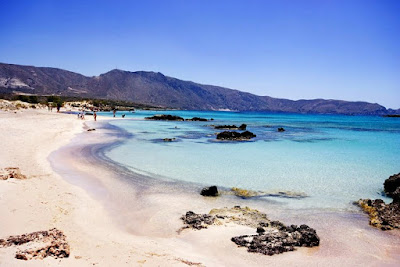
Nestled between the Aegean and Libyan Sea, Crete, the largest of the Greek Islands, sits at the southern most tip of Europe, the crossroad of cultures, civilizations, East and West, Africa and Europe.
The islands of the Aegean are peaks of underwater mountains that extend out from the mainland. Crete is the last of this range and boasts a diverse beauty from its high mountains of Psiloritis, Lefka Ori, Dikti, to its ocean caressed pink sand beaches.
Much of the island of Crete is Miocene and filled with fossil mollusks, bivalves, gastropods and their marine pals who lived 5 to 23 million years ago in these warm, tropical waters. One of the best collecting sites is the beachside haunt of Elafonisi, on the island’s southern tip, 43km from Kastelli and 76km from Chania.
Aside from the plentiful fossils in creamy pink limestone matrix, the beach is home to sun bathing locals and rare extant marine species. Pinniped Seals and Loggerhead Sea turtles call this part of the world home.
The fields are crimson, filled with lush, red Cretan Poppies. If you have a taste for something more remote, and venture into the local mountains, you’ll see wonderful folliage, exquisite orchids and deep in the forests the last remaining lynx, Roe Deer, Wild Goat and brown bear.
After a day of collecting, you can take in the vineyards to indulge in some fine cretan wine and local olive oil. Enough of either will inspire you to explore the local music scene with you doing a wobbly Pentozali impression by nightfall.
Where in the World:
Elafonisi (alternate spelling Elafonissi) on the southern tip of Crete, 43km from Kastelli and 76km from Chania. longitude 23o 30' 60" N, latitude 35o 15' 60" N
Getting there:
Both Aegean Airlines fly into Crete. If you stop to take in the monastery of Panagia Chrisoskalitissa, "Our Lady of the Golden Step," it is just a mere 6km further to the beaches of Elafonisi via a dirt road. If you are without a car, no worries, there is regular bus service to Elafonisi from Kasteli and Chania. Conveniently, the fossil exposures are easy to spot and a stones throw from the main bus stop.
There is so much more to say about Crete but I'll stop this adventure at Elafonisi. The island holds many mysteries and bountiful fossil finds, including the remains of Deinotherium giganteum, a massive 8 million-year-old mammal and primative relative of the elephants roaming the Earth today.
With an emormous large nasal opening at the centre of his skull, presumably to house a rather largish trunk, Deinotherium may be the inspiration behind the myth of the Cyclops, the one-eyed giant from Homer's famous Odyssey... but that is a tale for another day.
